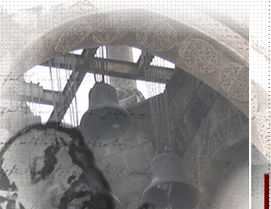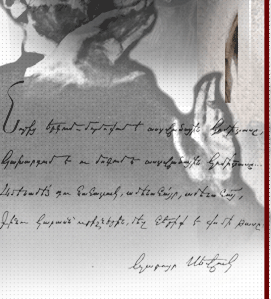KOMITAS' PATARAG
(THE LITURGY)
|
"The liturgy for men's chorus is not only the acme of Komitas'
creative work, but also quite a new stage in the development of
Armenian sacred music". - G. Geodakian
|
| Alongside
with folk songs, sacred music equally occupied the attention of
the great Armenian composer Komitas. Having grown up in Etchmiadzin,
educated at and worked in the seminary, he could not remain indifferent
to Armenian sacred music; thus, the creation of the Liturgy ("Patarag")
was not accidental from this point of view. The composition named
"Polyphonic Sacred Liturgy for Men's Chorus" was first
published in 1933 in Paris with the help
of the Komitas Committee. Komitas' student, the composer and conductor
Vardan Sargsian, edited the handwriting.
Komitas' Patarag differs from previous settings of the liturgy,
including that of Makar Yekmalian. Despite the fact that Komitas
criticized the latter in his review "The Music of Sacred Liturgy",
he highly appreciated Yekmalian's work and called it "the first
polyphonic blossom in the desert of Armenian sacred song".
Komitas' Patarag is noted for its unique and boldly innovative features and is even imbued with a secular spirit.
That is why the Armenian Church did not accept it and considered
it as a work not corresponding to its spirit.
Komitas tried to create a national liturgy. He strove to purify
the centuries-old singing of the Armenian Church from foreign or
extraneous features, recreate the initial beauty of national genres,
their reserved and majestic simplicity, and achieve intonational
and stylistic purity. While treating Armenian Church melodies, Komitas
avoided excessive decorations and meant to specify the construction
of melodies and to create a close connection between musical and
speech accents.
It took the composer a long time to choose the melody before the
creation of Patarag's score and its harmonization. Intending to
pick melodies most original and free from foreign influence, Komitas
turned to common village priests who performed those melodies according
to their traditions. It is known that the composer had several alternative
treatments of the Patarag. He wrote in one of his letters, "I have seven polyphonic
treatment variations of an Armenian liturgy, but they are not published
yet".
Komitas' Patarag is perfect in its own way. "Khorurd Khorin",
"Ter, voghormia" ("O Lord, save us!"), "Gohanamk"
are all brilliant examples of polyphony in which the composer aimed
to achieve a deep and expressive choral sound by widely applying
polyphonic devices. Using polyphonic means, he made an effort to
accurately and vibrantly present the spirit and character of the
Armenian sacred monody. His superb knowledge of choral nuances,
fabulous professional skill, free utilization of polyphonic principles,
and ability to reproduce the national character of Armenian sacred
music - all of these elements enabled Komitas to create a composition
of great value.
Patarag is both a concert and ritual composition bearing a stylistic
unity. It is one of the most significant achievements in the polyphonic
treatment of Armenian sacred music. According to Vardan Sargsian,
"Patarag is the highest peak of Armenian sacred music, where
majestic melodies created by our old church musicians once more
came out in their clear and characteristic forms, transformed into
a polyphony rich in images and colors of authentic melodies with
the hand of our great songwriter".
|


